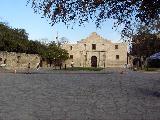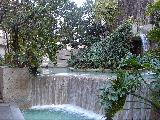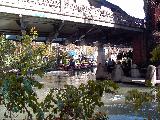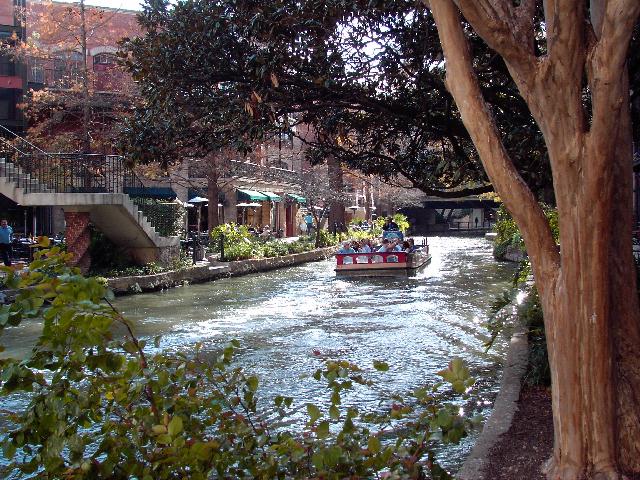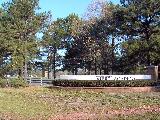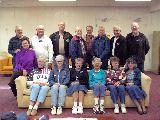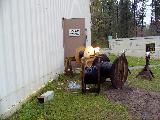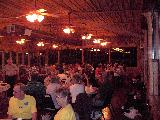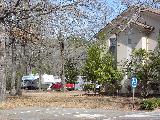If you haven't yet read Chapters 69-71-73-74, we suggest you do so. This part is kind of a continuation of what was said there. To do that, simply click on the one of the following: .Canada To Mexico - Chapter 69, In Mexico - Chapter 71, Back to the USA - Chapter 73, Back to the USA (Continued) - Chapter 74
A few months ago, I got an email from Paul and Juanita Alton, relating their very interesting experiences RVing from their home in Canada to a mission in Mexico. After reading Paul's vivid and detailed monologue of their maiden RV voyage, I emailed him back and told him that I'd be really excited to be able to send this along to those who read my Travel Log. Here's the story ----
Chapter 69 included a section "Canada to Mexico" on their trip down, and a second section "Into Mexico" that takes you to Oaxaca, Mexico. Chapter 71 tells of some of their "adventures" while in Mexico. Chapter 73, 74, and this one document their wanderings on the way out and back to the USA.
BACK IN THE USA
From an e-mail:
We are back across the border. We crossed at Pharr, Texas this afternoon and drove to Mathis before dark. We plan to drive to Austin tomorrow and spend a couple of days there. We need to be in Big Sandy on Saturday - the three week project there starts next Monday, March 4th.
The roads are much better on this side of the line. No damage today, nothing fell or broke.
CLICK ANY PHOTO (including maps) FOR A LARGER VIEW!
My Travel Log
Nothing in this site is copyrighted -- I'd be honored if you'd reuse anything you find here for your website
Click any photo for a larger view
77. From Canada to Mexico ... and Back - Part V
Other than normal inefficiency on the Mexican side and me driving down the truck lane on the US side (the customs officer was very helpful getting us backed up and turned around so I could drive the wrong way onto the bridge and turn down the car lane) the crossing was uneventful.
The signage on the bridge was ambiguous, mentioning only trucks and cars and I am never sure which we are. Later that day we were stopped at an immigration checkpoint and the signs were clear about what lane they wanted trucks, cars and RVs. No problem. After settling in on our site in Mathis we walked across the street for some wonderful Mexican food at good prices. In the morning we took our time getting underway. I went to top up the truck with diesel fuel and came back to hook-up the fiver.
The next day we drove toward Austin, stopped at a Camping World just south of there where we stocked up and then played with some radio controlled race cars as part of some contest. There were only two players so we each won something. I came in second. Juanita came in second to last. Having checked out the guide book for Austin it was no longer high on our list so we turned toward Bastrop and camped there for the night at another Passport America half price park for two nights. While we were there we did some walking around the large property and went to town for some shopping and Juanita did some sun bathing by the pool while I did some man type chores. It being March she had the pool to herself.
On Wednesday we mostly took ‘secondary highways’ (i.e. twice as good as any non-toll road and better than many of the toll roads in Mexico) through Palestine, Buffalo, Corsicana, and Athens to Tyler where we spent Thursday and Friday nights before showing up at the SOWERS (www.sowersministry.com) project in Big Sandy, Texas.
The next three or four paragraphs were written in present tense at the time.
We arrived in San Antonio a couple of hours later and dropped our rig at a RV resort park on the Passport America plan. We headed downtown and found a parking spot and walked to the Alamo and did the tour thing. On our way out we came to a snow cone stand and, primed by the stand in Catemaco, I ordered two. Culture shock time. “Six dollars, please.” Wow! I paid it while Juanita noted that “That’s supper.”
We head across the street and go down some stairs and past some stores and down some more stairs and past some pools and waterfalls and through a hotel lobby and find ourselves on the River Walk. In my ignorance I had thought that the River Walk was in Austin and that is why Austin was a destination for us. Time to revise plans. We walked along one side of the river for a mile or two and then cross over and walk back on the other side. As water taxis and tour boats plied the waters we walked the River Walk, passing the doors of upscale restaurants sidewalk cafes. At our crossover point we had to climb up to street level to get to the other side. The brief transition through city streets with tattooed, smoking, swearing, tough-looking male and female street people was a bit jarring to us as we descended back down the stairs to spic and span middle and upper income America. I get some store addresses from a tourist bureau and then it was back to the truck and off to those stores and back to the rig for the night.
We are working at ALERT (www.alertacademy.com) near Big Sandy, Texas, doing a SOWERS project. The day starts with devotions at 7:30 and the work day ends at 3:30 and the work week ends on Thursday so it is quite a bit less time demanding than the work schedule at the camp last summer or the orphanage this winter, but the work is still physically demanding. SOWERS are RV'ers who come onto a host ministry's site and stay there in their rv's and work for three weeks on tasks the host has laid out for them to do. Maximum size of a project is the number of sites the host has available in that time frame and the number of SOWERS who sign up to work. If there are more who bid than there are spots there is a lottery with names drawn. If there are fewer, then less work is done. This month there are about 300 SOWERS at work at around 185 projects around the States if my memory is correct.
Our project has 8 rigs: 7 couples and one single. The ALERT facility is huge. It was formerly Ambassador College of the Armstrongs' church and was sold at a relatively bargain basement price when that organization went through difficulties about five years ago. There were 120 employees responsible for grounds keeping and maintenance when it was Ambassador College and now there are six employees and some volunteers, including SOWERS so, it is an ongoing challenge to stem the tide of entropy.
The women work until noon on cleaning, weeding or painting type tasks. There is a team of men doing cement work at the waste treatment plant - removing forms and patching the holes from the form ties and setting the forms up in a new spot and filling them with concrete. The other team is pulling down the 4'x8' polystyrene suspended ceiling tiles in the convention center, measuring them, gluing the appropriate size strip on them to keep them from falling down and putting them back up. There are 1400 tiles so this task will take more than can be done in a three week window. The maintenance manager who just finished a three year stint here was quoted by somebody at his going away party "don't worry if you run out of time fixing something one day. It will still be broken tomorrow."
I am on a three-man team pulling fiber optic cable from the lake water pump house to the water treatment plant and another run from the water treatment plant to a communications hub in the campus library. It is about half a mile in total through conduit that other SOWERS buried in a project last year. Most of the runs are a bit to a lot too long and they saved money by using one inch conduit so I am pessimistic that the fiber pulled without damage.
We pulled most of the last run on Thursday and quit to go to a pot luck with other SOWERS from about five other projects in the area (YWAM, Sky Ranch, Rocking C, etc.). Two regular ALERT people (a "sergeant" and a "captain" - engineer in charge) helped for the last two hours on Thursday and stayed working when we left at 4:30 to clean up and change. There was about an hour's work left and we will shine a flashlight at one end of the cable on Monday and see if we can see it at the other end. If not we'll try to figure out what to do. What we did with one run the first week was cut-in part way and turn it into two runs and then splice the conduit back up with a slip coupling.
SOWERS pot luck:
The week after the above was written we checked out the cable and it was fine. After stowing the tools and tidying up junction boxes one of the team moved on to some fix-it work in one of the dorms and two of us remained on another little project in the water treatment area. We ran EMT conduit and cable between a chlorine residual analyzer and control panel in the water treatment plant next door to the building with the analyzer.
While we parked in Big Sandy I had time to pull the skin under the front overhang and check for cracks to the frame. None found. I took the opportunity to properly insulate the area while it was opened up. The factory job was to leave a couple of loose pieces of white bead board laying on the outer skin of the underside with the cold air from the front compartment able to circulate between the bead board and the floor of the bedroom and closet. Might as well been no insulation there at all. I glued in higher R-value pink board insulation to all the available spaces while the skin was off. The previous fall I had already done the more accessible front compartment so between the two the bedroom stays much toastier on cold nights than it did as it came from the dealer. Perhaps, next summer I will insulate under the black and grey tanks.
Our last day on the project was March 23. There was a week's free parking and hook-up for the rig after that. We went to Houston to see Juanita's sisters from March 25 to 28 and then came back to ALERT to start inching our way north on March 31. The geese had been flying overhead for a few weeks and the leaves and blossoms were breaking forth, but we didn't want to overrun the Spring wave any more than we had to in order to be back in Meadow Lake before April 15th. The plan was to drive back to Dallas (about a hundred miles) and then turn north and follow interstate highways north to Winnipeg then turn west to Regina and north from there.
In Houston we had time to visit several of Juanita’s kin, plus we had a chance to check out a SOWERS project south of Houston for future reference. We even attended the opening day of little league for Friendswood/Pearland and I was singularly impressed with parking spots for the season being auctioned for two thousand dollars for a two vehicle long “double”. Also went to our first two Fry’s Electronics stores. A bit more selection than the local Radio Shack!
From Texas to Home in Canada
A former pastor used to say “can any good thing come out of Texas?” Well, a lot of good people headed out at the end of the project, many of them out of Texas.
Big Sandy, TX to South Haven, KS
We have heard that the best time to go through a big city is at ten-thirty in the morning -the morning rush is over and the shoppers are not yet out in force. Our strategy for dealing with Dallas is based on this and works fine. Soon after approaching Dallas on the interstate from the east we have skirted the city and are on the interstate out of Dallas headed north toward Oklahoma.
It is midday when we reach the spot to exit to our planned stopping spot for the night and it is a bit of a way off the freeway and things are going well and the guide book is unclear whether the park has wireless internet so the plan changes and we carry on north to Kansas where the guidebook says the park has free wireless. As we cross into Kansas we are greeted with a warning sign that this is the last exit before the toll booth and it happens to be the exit for our campground for the next few nights so we exit and settle in at a Passport America spot about two miles west of the freeway. We get hooked up and settle in for a relaxing weekend.
On Saturday we take some two lane highways and check out things a bit to the west and then come back across the freeway to Arkansas City, the next town to the east, and then go south to Ponca City. This little city has been oil prosperous for a long time. We do some shopping, drive around town a bit, fuel up and then head west to the interstate and back to Kansas.
The wind was shaking the trailer like it was speeding down a Mexican back road and the internet was showing a Tornado watch so we put some ‘valuables’ in the truck and go to sleep in our clothes figuring on making a dash for the tornado shelter in the motel a couple of miles the other side of the freeway if necessary. At least, I slept, in the faith that Juanita would wake me if there was enough warning since there didn’t seem to be any way she was going to sleep and she says she didn’t.
The next day the park owner commented on how lit up his wireless hub was as all the campers checked on storm info the previous night. He also informed us the motel didn’t have a storm shelter and our best bet would have been to huddle under the overpass. Although apparently the local practice, if they have enough warning, is for the Sheriff to come by and warn people about which way the tornado is expected to come and direct them onto an appropriate highway that will tend to take them out of the path. He was quite blasé about the whole thing, but mentioned that his father as a young man had pulled a pile of bodies of tornado victims out of one town so he had spent his youth being herded at the first hint of a storm into a storm cellar his father had dug in their farmyard.
Growing up on the west coast I tend to be a little freaked out by tornadoes. I think it was Von Edge, who lived in California for years that mentioned he was likewise intimidated and then had a conversation with a friend visiting from the Mid West. The friend was paranoid about earthquakes. After most of his life in California Von could not name a single person he knew who had died or been hurt in an earthquake. The Mid-Westerner had the same observation about tornadoes. Such a perspective helps one to be fatalistic, I guess, but it’s like those battles where only one soldier dies. No big deal unless you are the soldier or his family.
South Haven, Kansas to York, Nebraska
On Monday morning we head north on highway 81 and bypass the tollway for about fifty miles into Wichita and take an on ramp onto a free freeway around the city. Didn’t see much other traffic and have no idea what sort of toll we saved, but why spend it if you don’t have to? We carry north on highway 81 into Nebraska. It is four-lane, divided highway most of the way. There are a number of digital speed displays to help you know how fast you are going. Our speedometer seems to be reading a couple of miles per hour below the radar guns, but that will reduce our risk of a ticket and will keep us in a lower fuel consumption pattern than if we chose to adjust for the difference and hope the radar guns are right and our speedometer is wrong.
At York we head east on the interstate for one exit and take the exit to the RV park in the Passport America guide. They don’t belong anymore but claim their off-season rate is lower anyway. We settle in and after a while head back to South Haven to find a post office. When we arrived at the park there was only one other rig, but as we leave for town more RVs are showing up and there are around twenty when we return.
I buy some bubble pack mailers and mail a CD of pictures to a friend in California, then we head around looking for a wireless hotspot to check e-mail and send an e-mail request to a friend in Florida for his mailing address. It is a bit exciting, but only a little productive as we find a few that come and go and one that is really strong when driving down the street, but which fades when we try and park anywhere.
Eventually we head out toward the freeway and stop for fuel at a truck stop. We get a very strong wireless connection and after fueling up, go park around back in the manager’s parking spot until she shows up and runs us off and we park out with the trucks and still get an okay signal. Then it is across the road to Wal-Mart to wait for a few minutes while Juanita buys a few things. As we leave the parking lot I notice the black mounds on the edges and realize they are mostly dirty snow not just dirt. We’re starting to get too far north if the snow hasn’t melted. Then it’s back to the park and, after supper a walk to the reception center to brave the second hand smoke and trade some pocket books. They got stowed in the basement compartment to air out.
York, Nebraska to Sioux Falls, North Dakota
Up early. Hook up the rig. Start the circle check I learned at truck driving school. Check fluid levels, start the engine and go around checking lights, connections, and tires, etc. Every couple of days when we are on the road I check the tire pressures with a gauge, as well as the trailer lug nuts with a torque wrench. In between I test the tires by thumping them with a piece of sledge hammer handle. The normal ringing sound on the front right tire is rather dull this morning and the gauge confirms the problem. So it's off with the engine and out with the compressor. This is the same tire that lost its valve stem in Isla Aguada and that had to be topped up a bit in Big Sandy the week before.
The intermittent leak and top-up continues all the way back home when I finally have time to check the cause. The valve stem leaks around the Mexican valve stem when it gets cold enough. Glad they didn’t have any others in Isla Aquada and I ended up putting German made ones on the other tires. A friend who used to run a tire store tells me the story of a case of Chinese valve stems his shop bought and used with every new tire installed until the first cold day in the fall and they all started leaking around where the stems seats in the rim. I guess they work fine where it never gets cold. O my truck there is now a semi type steel valve stem in the right front rim. The other tires will have the same next time they are changed.
Onward and eastward we go to Omaha and then follow the interstates and turn north toward Canada on a familiar interstate that we have used many times when headed east to Tennessee. The next morning we continue north while listening to local radio reports of flooding and national radio reports of schools in Denver banning the wearing of red, white and blue clothing because it is provocative to the children of illegal Mexican immigrants.
After enduring road work through Sioux Falls we get to interstate 90 and head west toward Mitchell, South Dakota. There is a shortage of RV parks open in early April in this part of the country and Mitchell is out of the way, but the closest open one we can find in our directories. The interstate is paved, but rides like washboard. We slow down but even then the pounding is almost unbearable. We abandon plans to go to Mitchell and turn around at the next exit and head back to Sioux Falls and the Flying J truck stop. We fuel up and ask for permission to park and then we go and find a spot. I sign up for 24 hours of wireless internet and pick up e-mails. On our way to supper at the flying J buffet we mail the CD to the friend in Florida.
Sioux Falls, North Dakota to Portage la Prairie, Manitoba
We are on the road early the next morning listening as we drive to reports of flooding in South and North Dakota. Many of the ditches are filled right up to the shoulder of the freeway. A few times the road narrows to one lane each way and there are a few inches of water running across the lanes in use. Traffic slows right down.
Our plan was to stay at a park in Grand Forks that listed itself as opening April 1st each year. We planned on dumping our tanks at the last possible spot before we got home and to get all our receipts in order for customs. We followed directions and got the right exit and headed south on a gravel road paralleling the freeway.
We could just see one rig as we turned into the driveway of the park. It was by itself out on a site toward the edge of the property. Several of the roads and sites were under water. As we got closer to the visitor center we realized all roads further into the property were deliberately blocked by vehicles and equipment. There was not a person to be found. After turning the rig around with great difficulty in the space they had left without vehicles and not a little radio work we used the dump station, threw a few bucks in an envelope for the privilege, opened the fresh water tank valve and the hot water tank valve to drain and went to a truck stop up the way and sorted and totaled our receipts in the café over some coffees.
Then we headed to the border and the classic dilemma over whether an RV should stay in the truck lane. The answer is "no", but it would be nice to find that out before an hour of obedience while the car line is often empty. We go through the checkpoint and then park the rig and go inside to pay the gst on the amount over our personal limits. We are processed politely and professionally while we listen to somebody complaining loudly on the pay phone to somebody that he wasn't allowed into the States and would be coming home on the next bus. Brought to mind my favorite solution to the changes that will require people entering the states to need a passport – let all the Americans into Canada with the used-to-be-good-enough documentation without warning them they need different documentation to get back out and then let them deal with the congress critters that set them up to be stranded in Canada. There are worse places to be stranded.
We fueled up on the south edge of Winnipeg and took the ring road around it to the west and got on the Trans-Canada. At this point in its coast to coast extent it is too narrow and too rough to be proud of. Welcome to Mexico North. We carry on to Portage la Prairie and take the old road through town rather than the new bypass despite the navigator intuiting rather loudly that the Wal-Mart mentioned on the "Opening Soon" sign would be on the bypass. It wasn't and the sign must have been an old one since the Wal-Mart we came upon in mid-town looked pretty well established. Juanita headed for the Safeway for cold cuts and buns and I headed to the Wal-Mart for RV antifreeze and winter windshield washer fluid. After closing and opening the right valves the water pump sucked in antifreeze and distributed it throughout the plumbing system and the rig was ready for the winter that it must have thought it had been spared from. It was time for a sandwich and a fitful sleep between two semis whose drivers didn't believe in shutting down their engines.
Portage la Prairie, Manitoba to Meadow Lake, Saskatchewan
We were up before six and on the road right after getting a coffee from the Tim's in the parking lot. It was still dark as we passed through the rest of that frozen prairie town and stopped a few miles out of town for fuel. We had hoped to have stayed on divided highways as much as possible. You are not holding anybody up and there is nobody crossing over the center line in your direction. As we got closer to Brandon we started listening to the Morning Edition on CBC out of Regina. They were giving high wind warning so we turned north at Brandon and headed for the Yellowhead highway which angles northwest to Saskatoon.
Last fall we watched the geese head south over our heads for almost a month before we followed them. This spring, in Texas, we watched only for about two weeks before we headed north. As we pass by the geese standing on frozen ponds in Manitoba and Saskatchewan I wonder if they regret their haste. I regret our haste somewhat, but also have to live within the provincial medical insurance requirements of staying at least six months a year in the province. I wonder what their excuse is.
We got through Saskatoon and performed the normal RV acrobatics in the Costco parking lot on the northside and went to the Husky truck stop and filled up with fuel. After vowing to myself that I would rather starve than pay six bucks for an anemic looking sandwich we left and headed for North Battleford and then Meadow Lake. We, of course, stopped in Cochin for some fried chicken at the native gas station – way better than a sandwich.
Ten miles south of Meadow Lake we turned off on the grid road to our property. I parked the rig on the edge of the junction with the old highway and started to walk the mile along the road to our driveway. A stranger stopped and picked me up and gave me a ride. I am grateful for the ride and he was probably grateful for satisfying his curiosity. I unlocked the gate, walked into the property and checked things out. The pad had been plowed by Willie MacAmmond as we had arranged the previous October and was clear of snow. The driveway was only a little soft and the grid road itself had a few patches that were scary, but nothing that looked like it warranted spending the night in town in a parking lot while some overnight freezing helped things out. I walked back to the old highway said "let's go for it" and we did. Juanita make a few exclamatory encouragements about not stopping at some of the soft spots, especially the one where the rig was moving somewhat sideways, but we got onto the pad okay.
I had cut the turn onto the pad a bit short for my liking, but moving back and forth in an attempt to right things brought me to the same spot. When starting another attempt the trailer wheels started to sink and I quickly decided the orientation was "perfect". More of that relativity theory stuff, I guess. We chocked the wheels and dropped the landing gear and tried to unhitch. No luck. No room to maneuver between the stumps of the trees we cut down and the trunks of the ones we left when making the pad two years ago. We tried pulling the hold down pins on the hitch deck and lifting the deck out of the guides. It appears that one of the crunching noises in a tight turn was a guide post being bent toward its partner. This meant that as we raised the trailer with the landing gear, the landing gear motor torqued out and started clicking even though there was more room to travel in the gear. After some brutal strategic and not so strategic (the blood blister healed in a couple of weeks) beating and prying we got the truck and trailer apart and I drove the truck ahead and maneuvered it around the obstacles we had left in a weak, tree-hugging moment. We put out the slides and headed to town to see the grandkids and son-in-law at home and our daughter at work at the supermarket. I topped up the fuel tank for statistical purposes (see below). We were back.
Since then we have applied over fifty pick-up loads of gravel to the driveway and pad (springtime road bans prohibit full dump truck loads of gravel). Some further manual labor with chainsaw, winch and shovel has removed all the former obstacles and made the pad much firmer and wider. We look forward to being able to get on and off in under a wider set of conditions and hope never to experience the debacle of last July 1st when we buried to the axles twice. The hitch has been subtly modified to not catch on the rig. This was done without sacrificing its strength properties.
At the end of June we will be back on the road to our summer work at Bethel Gospel Camp In Meadow Lake Provincial Park just north of here. Next winter? We'll see but we are praying and planning and, strangely enough, are sure homesick for Mexico.
Paul and Juanita Alton paul.alton@hughes.net
Stats:
Out of Saskatchewan (Oct. 15/05 - Apr. 6/06) 173 days
Out of Canada (Oct. 22/05 - Apr. 5/06) 165 days
In United States (10/22/05–11/10/05, 2/26/06-4/5/06) 57 days
In Mexico (Nov.10/05 - Feb.26/06) 108 days
Odometer readings at Meadow Lake 34,947 km. start
57,146 km. finish
Distance traveled 22,199 km. 13,794 miles
Diesel fuel consumed 5,114 liters or 1,351 us gal.
Fuel economy 23.04 L/100 km 10.2 mpg
Cost of Fuel: ~$C 3,960 ~$US 3,530
(depends on exchange rates, actual cost per leg = $C 542.11 + $US 974.69 + $MX 9,289.24 + $US 820.97+$C 361.30)
Cost of fuel per unit distance $C 0.179/km. $US 0.256/mi.
Average fuel price $C 0.78/liter $2.61/us gal.
Cost of Mexican Truck and Trailer Insurance $US 982.54
Cost of Blue Cross Coverage for out of Country $CN 765.60
Memories: Priceless
Sorry, no enlargements available on photos below



